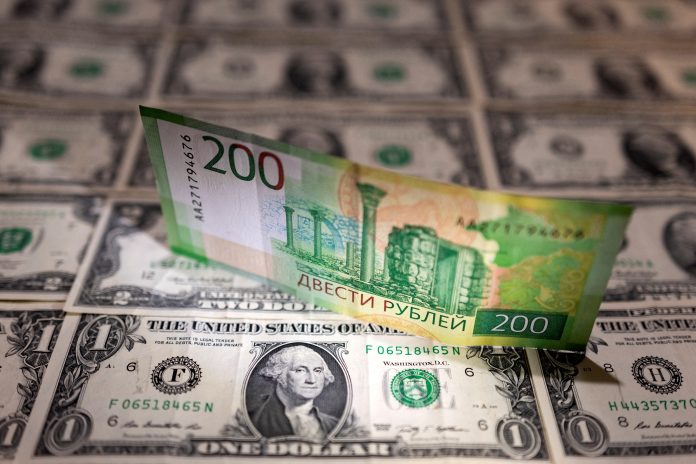Russia’s external debt has been steadily declining, reaching $326.6 billion in December 2023, down from $322.3 billion in the previous quarter and $383.6 billion at the end of 2022, according to bne IntelliNews.
Low external debt means Russia does not need to access international capital markets, so it is not vulnerable to any sanctions on bond issuance, which is easy to apply and enforce.
Combined with Russia’s strong current account surplus, which was up to $5.2 billion in February from $4.5 billion in January, thanks to high oil prices, Russia can easily finance itself with these profits.
Gross international reserves have been rising and are now hovering around $600 billion at the end of the first quarter. Half of these reserves are frozen. About $150 billion is in monetary gold and the rest in yuan.
As a consequence, Russia is able to cover its foreign debt dollar for dollar in cash, while everyone in the West is hugely leveraged, including Ukraine, where the debt-to-GDP ratio is almost 100 per cent.
The solid foundation means that even if the West manages to cut Russia’s oil and gas export revenues, it still has huge room for manoeuvre. This is the very essence of Russia’s financial fortress.
In addition, the basis for this is the continued export of commodities to the south of the world, which means that Russia will continue to receive subsidies on raw materials for its economy. Thus, Russia is probably currently the least vulnerable in terms of macroeconomic performance.
That said, the Ministry of Finance is increasingly turning to the domestic OFZ treasury bond market to finance a deficit that is expected to be 1.6 trillion rubles a year, up from 3.4 trillion rubles last year, or 0.8% of GDP and 1.9% of GDP respectively. Before the war, the Ministry of Finance issued OFZs worth about 2 trillion rubles ($20 billion) a year, most of them with very long maturities of up to 20 years.
Issuance volumes increased dramatically. In a hushed-up story, Siluanov said that early last year the Finance Ministry had planned to issue about 1.5 trillion rubles ($20 billion) in OFZ, but ended up issuing 2.5 trillion rubles. The plan for this year, at the beginning of last year, was also 1.5 trillion rubles, but in December Siluanov spoke about 4 trillion rubles. – This is almost double the pre-war level.
The total amount of outstanding OFZ has doubled to 20 trillion rubles since the pandemic began, when Russia spent about 3% of GDP on economic aid. You can see that debt levels have risen sharply again since the start of the war, and total outstanding loans are now around 20 trillion rubles ($200 billion).
An outstanding domestic debt of $200 billion is not a bad thing, why? Firstly, there is a pool of liquidity in the banking sector of around 19 trillion roubles, so again, all of this debt can be covered in cash from domestic resources. Secondly, £200bn is about 10% of GDP, so even this borrowing is extremely modest by the standards of a developed economy and easily managed.
